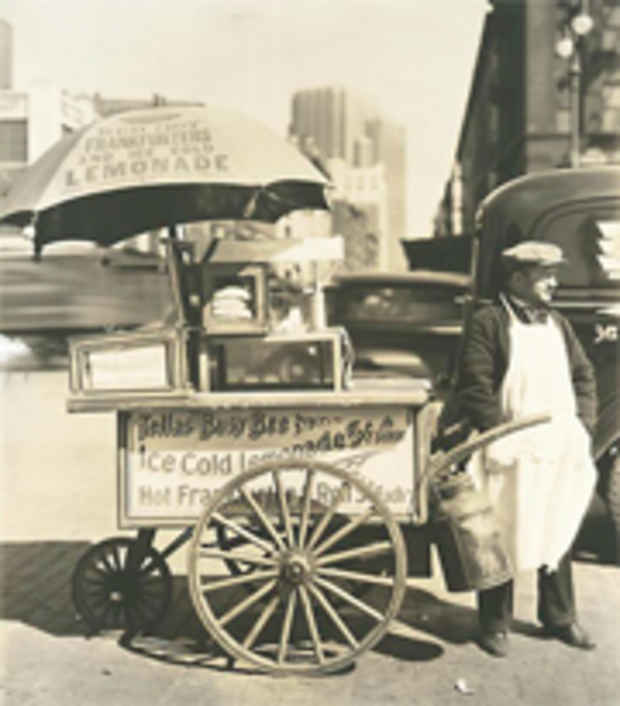"Lunch Hour NYC" Exhibition
New York Public Library Stephen A. Schwarzman Building

This event has ended.
“Every thing is done differently in New York from anywhere else—but in eating the difference is more striking than in any other branch of human economy.”
—George Foster, New York in Slices, 1849
The clamor and chaos of lunch hour in New York has been a defining feature of the city for some 150 years. Visitors, newly arrived immigrants, and even longtime New Yorkers are struck by the crowds, the rush, and the dizzying range of foods on offer. Of the three meals that mark the American day, lunch is the one that acquired its modern identity here on the streets of New York.
Colonial American mealtimes were originally based on English rural life, with a main meal known as “dinner” in the middle of the day. The word “lunch” referred to a snack that might be eaten at any time of the day or night, even on the run. But during the 19th century, under the pressures of industrialization, this meal pattern began to change. Nowhere was the change more dramatic than in New York, the burgeoning center for trade, manufacturing, and finance. Employees were given a fixed time for their midday meal, often a half hour or less. So, dinner was pushed to the end of the day, and lunch settled into a scheduled place on the clock between the hours of twelve and two.
Lunch Hour NYC looks back at more than a century of New York lunches, when the city’s early power brokers invented what was yet to be called “power lunch,” local charities established a 3-cent school lunch, and visitors with guidebooks thronged Times Square to eat lunch at the Automat. Drawing on materials from throughout the Library, the exhibition explores the ways in which New York City—work-obsessed, time-obsessed, and in love with ingenious new ways to make money—reinvented lunch in its own image.
Organized in four thematic sections— quick-lunch, lunch at home, charitable lunch, and power lunch—Lunch Hour NYC reveals how the city's pace and people have influenced where and what we eat. From kitchen tables to cafeterias, oysters to Jamaican beef patties, the changes in lunch reflect demographic shifts, economic development, and the city's historic appetite for new foods.
While some classics endure—the "power lunch" restaurant has been with us since Delmonico's set the standard in 1837—other features of the city's culinary landscape have transformed over the years, especially in response to new waves of immigration.
“Lunch Hour NYC is the best kind of food story, full of familiar landmarks but with a history that's new to most people,” said culinary historian Laura Shapiro, co-curator of the exhibition with NYPL Librarian Rebecca Federman. “If you want to explore the place where food, people, and New York City come together, it has to be lunch.”
Visitors will learn about the development of the public school lunch program in New York, which began as a charitable service for underserved children in 1908; how street foods like pretzels, pizza, and hot dogs gained their New York identity; how changing fashions contributed to the rise of salad and other diet food; and how the demographics of New York’s workforce guided the spread of new kinds of restaurants, including cafeterias and the Automat.
Lunch Hour NYC highlights books, pamphlets, photographs, menus, manuscripts, and memorabilia from various collections at The New York Public Library.
“One important feature of this exhibition is the chance to see some of the lesser-known treasures of the Library—the recipe pamphlets, for instance, and a manuscript cookbook—that really tell us about the history of everyday life,” said Librarian Rebecca Federman.
Specific items on view include:
• menus from restaurants like Schrafft’s, Delmonico’s, and Forum of the Twelve Caesars;
• Noah Webster's personal, annotated copy of his 1841 dictionary, showing the entry for “lunch”;
• pages from the Horn & Hardart restaurant manager's book, which instructed employees on preparing menu items and managing the shop;
• a reconstructed wall of Automat machines, including a peek at the back, where restaurant workers loaded the food;
• a mid-century business map of midtown Manhattan, which offers evidence of the number of eating establishments around Fifth Avenue and 42nd Street;
• photographs by Lewis Hine and Berenice Abbott;
• and famous caricatures that once hung on the walls of Sardi's.
The exhibition features multimedia like film clips, songs, and interviews as well as interactive components, including a “10 cent meal” activity that explores how turn-of-the-century tenement housewives fed their families on very little income. Visitors will also be invited to lift the doors of the Automat and take home recipes based on those used in the famous Horn & Hardart restaurants.
A number of programs will be held throughout The New York Public Library system this summer in conjunction with Lunch Hour NYC, including cookbook-author talks at Mid-Manhattan Library, a neighborhood library summer film series, and storytelling events for children.
Media
Schedule
from June 22, 2012 to February 17, 2013